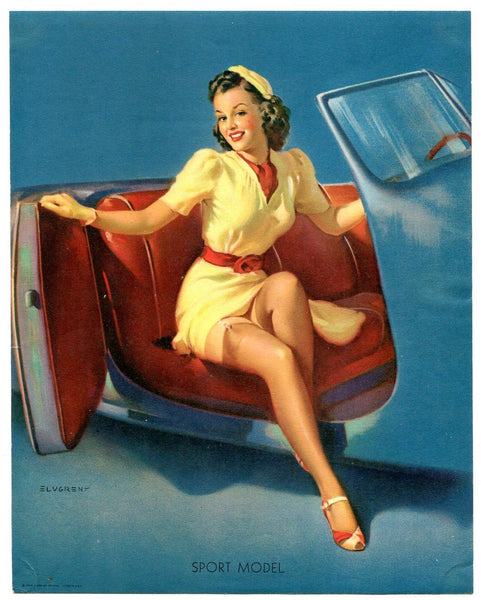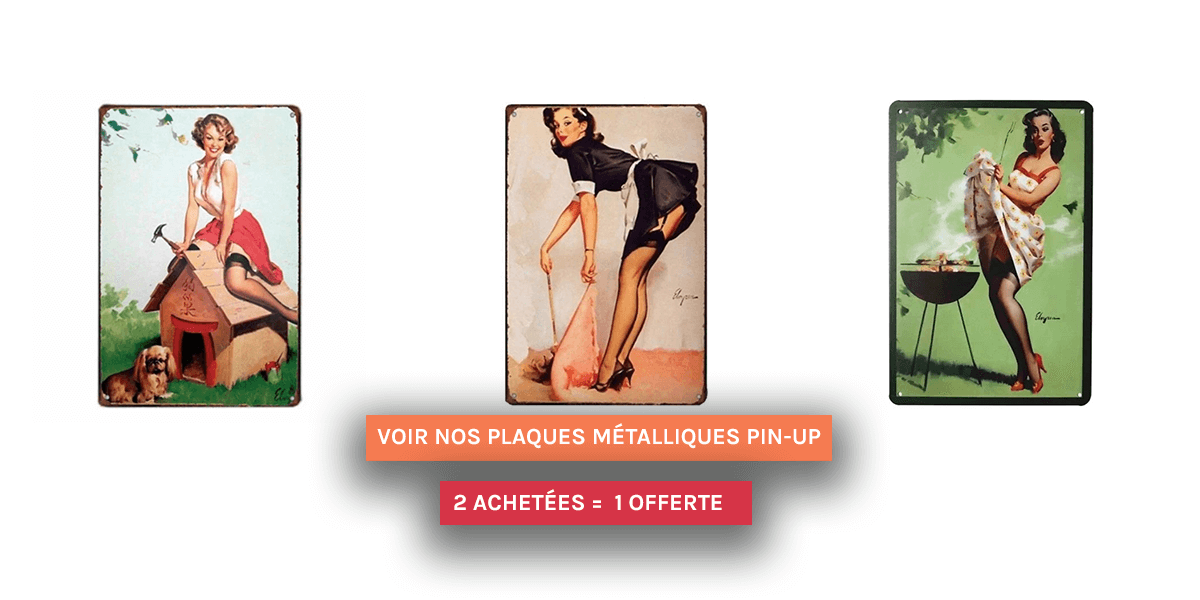
The Art of Gil Elvgren (Part One)
Gil Elvgren (1914-1980) was the most important pin-up and glamor artist of the 20th century. During his professional career, which began in the mid-1930s and lasted more than forty years, he established himself as a favorite of pin-up collectors and fans around the world.
Although most of his works were created for commercial use, they are increasingly recognized as "real" works of art by many private collectors, dealers, galleries and museums. And indeed, although Elvgren was considered a primarily pin-up artist for the past half century, he actually deserves to be recognized as a classic American illustrator whose career encompassed many different areas of commercial art. He has always been a master in the art of representing female beauty , but his output has not been limited to the pin-up industry.
His beginnings and career at Louis F. Dow
In 1936, Gil Elvgren completed his first paid commission: a fashion catalog cover, depicting a handsome young man dressed in a double-breasted jacket and cool white summer pants. The original work was done in oil paint and was not signed, as specifically requested by the company's artistic director. No sooner had Elvgren delivered the artwork than the company's president called to congratulate him and order half a dozen more catalog covers. The young artist was on his way to glory!

Gil Elvgren's first commercial work (1936)
The next "decisive" call followed a few weeks later. This time it was about a possible advertising commission for which Elvgren had to introduce himself and his portfolio. The mission, he learned, would be to portray the Dionne Quintuplets , who caused a sensation in the American media. It was the breakthrough Elvgren had dreamed of but didn't expect to achieve for several years. And more than the beautiful children, the order had another decisive feature: the client was Brown and Bigelow , the largest and most important calendar company in the world. Elvgren's two paintings of The Dionne Quintuplets were published in the 1937 and 1938 calendars and were enormously successful. The fact that Brown and Bigelow paid the quintuplets a total of $58,097.17 that year in royalties shows how extremely popular Elvgren's first two calendar paintings were. Needless to say, everyone in the company was happy with Elvgren!

Painting of the Dionne Quintuplets for Brown and Bigelow (1937)
In early 1937, Elvgren was approached by Brown and Bigelow's largest competitor, the Louis F. Dow Calendar Company, also located in St. Paul. Their art director wanted Elvgren to paint a series of pin-ups, an assignment he enthusiastically accepted. The young artist couldn't believe his eyes: not only was he lucky enough to achieve such "breakthroughs" so soon after opening his first studio, but he was also going to paint beautiful girls and see his work widely reproduced in calendars. What Elvgren did not realize was that the Dow Company would reproduce his work in several additional formats, including notepads, ink blotters, mutoscope cards, matchbooks, and playing cards. They even produced specially designed booklets with an Elvgren pin-up on the cover and a dozen of Elvgren's drawings inside measuring 8" x 10" (20.3 x 25.4 cm).

Gil Elvgren's first painting for Louis F. Dow & Co (1937)
When Elvgren left Dow in 1944 to work again for Brown and Bigelow, Dow hired an artist to paint parts of the pin-ups he had done for them; this way, Dow could use the images a second time without having to pay Elvgren any fees or royalties. Fortunately, the artist selected for this task, Vaughan Alden Bass , was very competent and approached the work with great respect for Elvgren's talent. Thus, Bass typically painted only on the clothing and/or background of an Elvgren painting and left the face, hands, and legs intact. A good example of Bass's approach is the overpainted version of Elvgren's A Perfect Pair (originally painted in 1940) .

A Perfect Pair repainted by Vaughan Alden Bass

The original "A perfect pair" (1940)
By 1938, more than 6,500 of his nearly life-size pin-ups for Royal Crown Soda were distributed to grocery stores across the United States. The year 1938 was also significant for Gil and Janet Elvgren for an entirely different reason, as they became the proud parents of their first child , Karen.

Advertisement for Royal Crown soda (1938)
For the next two years, Elvgren was very active in advertising , magazine writing, and, of course, his pin-ups for Louis F. Dow. With Gil's fantastic professional success and the added joy their first child brought to their family life, the couple felt ready to consider how best to shape their future. Most of Elvgren's business came from Chicago and New York. There was no doubt in his mind that he could do even better if he was based in one of these two art centers. As they had once before, they chose Chicago, and the family prepared to move.

Sitting Pretty (1940)
Shortly after arriving in the Windy City in 1940, Elvgren obtained a position at the famous Stevens/Gross studio. There he met the man who would become his true mentor, Haddon H. Sundblom (1899-1976). Not only would the two men become best friends, but Sundblom's influence on Elvgren's artistic development would be enormous. The old artist was already a form of idol for Elvgren. The young man had collected a file of sheets about Sundblom long before they met, and while most of the sheets were illustrations of magazine articles, the famous Coca-Cola advertisements were also among them. (It was Sundblom who introduced Elvgren to the Coca-Cola Company, which resulted in Elvgren's Coca-Cola ads appearing alongside Sundblom's on newsstands, on billboards and calendars).

Advertisement for Coca-Cola (1940)
As their friendship developed, Sundblom introduced Elvgren to Andrew Loomis (1892-1959), who was also one of Elvgren's early heroes. Both Earl Gross and Howard Stevens agreed with Sundblom that Elvgren was the ideal candidate to take over much of the Coca-Cola advertising work that their studio was producing for the Atlanta-based company. This decision was a milestone in Elvgren's career; it led to the first in a twenty-five year series of advertising work for Coca-Cola that are now considered benchmarks in the history of American illustration.

One of Gil Elvgren's many Coca-Cola commercials
Immediately after the bombing of Pearl Harbor, General Electric asked Elvgren to do national publicity work for its war effort campaign. Her first advertising painting for the company, published in June 1942 as a full-page spread in Good Housekeeping, bore the caption " She Knows What Freedom Really Means " and depicted a proud Elvgren Girl dressed in a Red Cross Motor Corps officer's uniform.

She Knows What Freedom Really Means (1942)
Also on the home front, Elvgren's pin-ups produced for Dow continued to enjoy great popularity, with calendar prints now often used to raise funds at bond rallies. Men and women could use their free time to put together a puzzle with an Elvgren pin-up. Elvgren's best-selling picture at Louis F. Dow had been his Perfect Pair, but it was closely followed by The High Sign . The latter was so successful that it was the second image Dow commissioned Vaughan Alden Bass to overpaint during the war years.

The High Sign (1942)
With the birth of Gil Jr. in 1942, the Elvgren family grew. Business is also growing. Later that year, Elvgren undertook a series of national advertising paintings for Four Roses , a whiskey company that wanted its product featured in a recreational setting. The first published painting depicts a group of men enjoying their favorite beverage during a deep-sea fishing excursion.

Advertisement for Four Roses (1942)
The year 1943 was another record year for Gil Elvgren . Her schedule was full of orders, her children were growing up, and Janet was pregnant with their third child. Louis F. Dow aggressively marketed and promoted the pin-ups that Gil had done for the company several years before. Life seemed pretty good for this talented and respected artist and happy family man. However, subsequent events put all of this in the shade.

Sports Model (1943)
It all began in 1944, when Elvgren was approached by Brown and Bigelow to join the team as an artist. This invitation meant that his work would be in more or less direct competition with the work of the Dow's other pin-up and glamor artists, who were the crème de la crème in this field.
Before committing to work exclusively for Brown and Bigelow, Elvgren accepted his first (and only) commission from the firm of Joseph C. Hoover and Sons of Philadelphia to paint a glamorous female subject. As he did not want to cause problems with Brown and Bigelow, he accepted the work on the condition that Hoover accept the painting without a signature and not publish it as his work. This painting was called Dream Girl and would be published in 1945.

Dream Girl (1945)
In 1945, this painting became the best-selling "evening dress" pin-up ever published by Hoover. It was kept in their Superior line for over ten years, and in 1945. After the rapid success of Dream Girl, the president of Hoover suggested that Elvgren do a series of calendar paintings, but at that point he decided to accept Brown and Bigelow 's offer.
To be continued in our second part of the art of Gil Elvgren !










Leave a comment